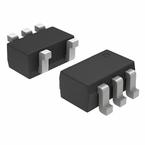herunterladen

Semiconductor Components Industries, LLC, 2002
August, 2002 – Rev. 0
1 Publication Order Number:
AND8096/D
AND8096/D
Unique One Gates Make
Voltage Bilateral Level
Translation Simple
Prepared by: Fred Zlotnick
ON Semiconductor
Applications Manager
The ability to “mix and match” technologies creates a
unique opportunity to solve difficult problems. Figure 1
shows a design with the low voltage side at +2.7 V and
that must drive a 5 V data line on an external module. In
addition, the 5 V data line is connected to the 5 V supply
voltage, through a 4.7 kΩ resistor. This is used to detect the
presence of a 5 V module.
The simplest way to do this is to use the ON
Semiconductor’s “T” version one gate products, in
conjunction with standard CMOS products. The “T”
version VHC family is designed to operate at 5.0 V and its
input threshold is V
IL
of 0.8 V and V
IH
of 2.0 V. This
matches very nicely with the standard CMOS 2.7 V output.
In addition, the “T” level devices can easily drive the 4.7 k
resistor, since it can source and sink 8 mA. In order to get
bilateral ability, tri–state devices were selected. Going
from the 5.0 V side to the 2.7 V, a standard level VHC or
LCX one gate is used. Both of these families have
overvoltage tolerance at their inputs. The design takes
advantage of this fact and by operating the part at 2.7 Volts,
while its output is matched to its supply voltage. The
designer is free to drive the input up to +7.0 V. The choice
of which device to use is dependent upon the speed
required. If the application requires more speed the LCX
family (NL17Szyy) should be selected, if delay time is not
extremely important, then perhaps the VHC device should
be used (MC74VHC1Gyy).
The design is very simple, just placing a “125 and “126”
back to back allows the two devices to function as a single
bilateral device. The EN line of both devices are in parallel.
The 125 is low enable, and the 126 is high enable, this
permits the two devices to function as a data direction line.
The software engineer should take care to establish zeros
on both sides before reversing direction, and holding this
for about 20 ns, otherwise one of the tri–states can present
a very low impedance to the device that is driving it. The
design shows using a “T125” on the 2.7 V side, and a “126”
on the 5 V side, this means it requires a voltage lower than
0.8 V for the combination to go from the 2.7 V to the 5 V,
and a +2.0 V signal to make the transition from the 5.0 side
to the 2.7 V. By swapping a “T126” and a “125” the sense
of the data direction can be turned around. The data
direction line can come from either the 2.7 V side or the
5.0 V side, it makes no difference. The 4.7K resistor in the
circuit is easily driven by the VHC device.
MCU
Data
Data Direction
MC74VHC1G126
NL17SZ126
MC74VHC1GT125
+5.0 V
+5.0 V
+2.7 V
4.7 k
5 V I/O
5 V Card
Figure 1.
APPLICATION NOTE
http://onsemi.com
Verzeichnis




